Pervaiz Munir Alvi
Iqbal Hussain (1950- ) is often termed as the ‘controversial artist of Pakistan’. Although he is equally masterful in painting landscape and still life, yet he is best known for his portraits–mostly portraits of women that is.
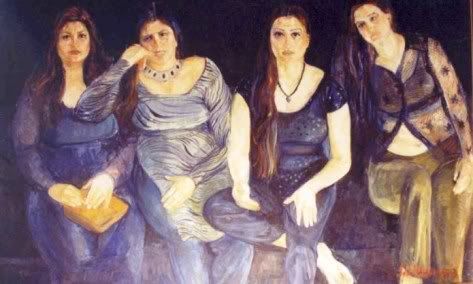
He paints his landscape in romantic hues of dusty pink and soft blue and because of that has been called “Turner/Monet of the Punjab Landscape Schoolâ€. But in contrast to his style of landscape he chooses to paint his women in bright colors under full light with purposeful brush strokes. He is an impressionist and a realist at the same time. It appears as if intentionally, in his impressionism style landscapes he takes his viewers to a retreat of romantic dreams, but in his portraits in a clear opposition, he forces his viewers to see life in its stark realities.
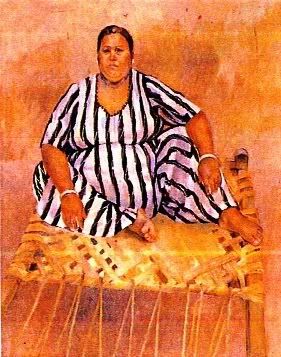
So what is controversial about the art of Iqbal Hussain? Nothing really if you ask any art critic. An artist and his art could be escapist and realist at the same time. What makes him ‘controversial’, and that is mostly within Pakistan, are not his contrasting artistic styles but his conscious choice of female models and the way he presents them. Iqbal Hussain as a realist does not exaggerate or minimize the physical characters of his subjects like say Picasso would.
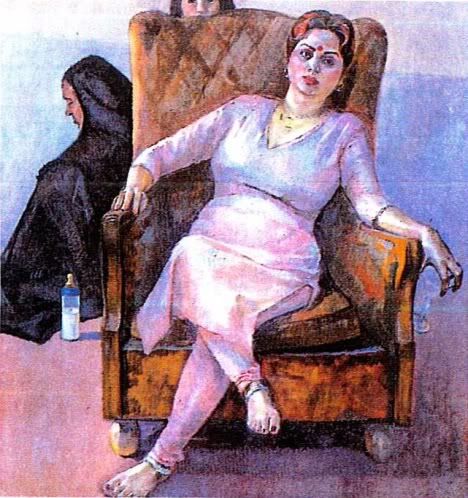
He paints his women the way they are in their real life. He just happens to show the side of life we wish not to acknowledge existing in our midst.
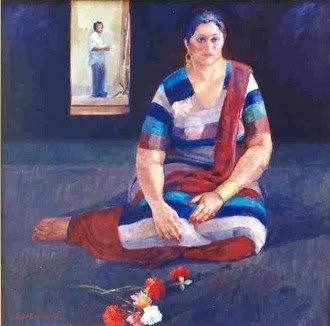 His fault is that he brings out in the open the ‘controversies’ that already exist within our societal norms and values; an act for which ‘respectable’ society has termed him as a ‘controversial’ artist. He is controversial because his women do not depict our perceived image of our self. We would like to think that his class of women does not exist in our Pakistan.
His fault is that he brings out in the open the ‘controversies’ that already exist within our societal norms and values; an act for which ‘respectable’ society has termed him as a ‘controversial’ artist. He is controversial because his women do not depict our perceived image of our self. We would like to think that his class of women does not exist in our Pakistan.
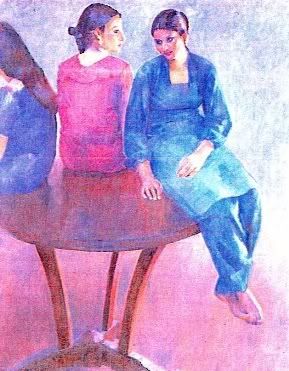
Because of his choice of female models, Iqbal Hussain like Henri de Toulouse-Lautrec (1864-1901) is called a “painter of prostitutes and dancing girlsâ€.
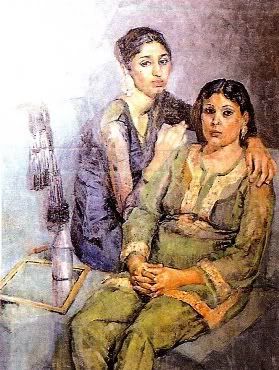 Most of his models are the ‘professionals’ from Shahi Mahalla of Lahore whom he is either related to or he knows them personally. The famous red light district of Lahore is his Montmartre and Pigalle. His home is his Moulin Rouge.
Most of his models are the ‘professionals’ from Shahi Mahalla of Lahore whom he is either related to or he knows them personally. The famous red light district of Lahore is his Montmartre and Pigalle. His home is his Moulin Rouge.
But unlike Henri his girls are not shown in dancing forms, lifting their skirts, and exposing their legs and petticoats. Iqbal’s women are not nude or semi-naked or involved in some illicit acts as their profession might suggest. They are not even dancing suggestively or posing provocatively as they do during their work hours.
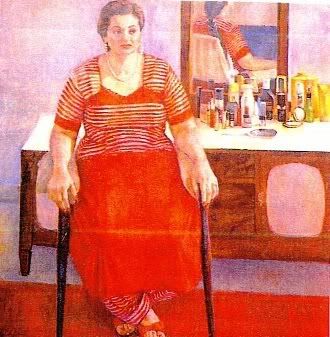
They are mostly some unknown and unremarkable women of modest looks and appearance. They are just there as they are in their real life; fully clothed stout women, sitting, squatting and with their blank eyes and resigned looks staring at the artist or simply at the empty air in front of them.
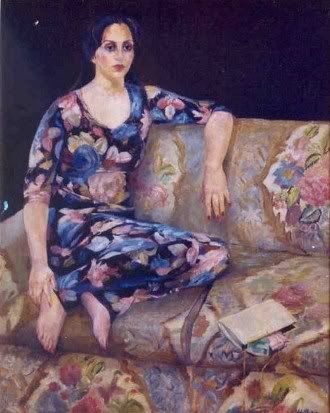 Ah, but they are the prostitutes from that ‘bazaar’ and that’s what is ‘controversial’ about Iqbal and his portraits. Iqbal’s women, unlike most respectable Pakistani women do not have their heads and bosoms covered with dopattas and chadors of ‘modesty’. They are bare footed and without the shoes of ‘respectability’. But what troubles us most in Iqbal’s women is the fact that they silently poke our conscience and raise questions about the otherwise obvious hypocrisy of our society.
Ah, but they are the prostitutes from that ‘bazaar’ and that’s what is ‘controversial’ about Iqbal and his portraits. Iqbal’s women, unlike most respectable Pakistani women do not have their heads and bosoms covered with dopattas and chadors of ‘modesty’. They are bare footed and without the shoes of ‘respectability’. But what troubles us most in Iqbal’s women is the fact that they silently poke our conscience and raise questions about the otherwise obvious hypocrisy of our society.
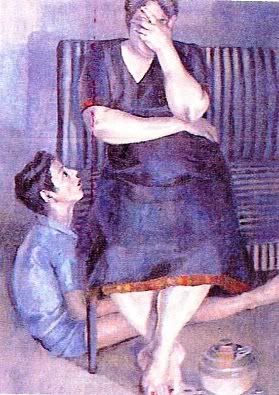
They raise the questions that ‘respectable’ Pakistani society rather not to ask of it self. And that is what makes Iqbal Hussain so ‘controversial’!
Source:
Contemporary Painting in Pakistan, 1992.
By Professor Marcella Nesom Sirhandi, Ph.D.
Ferozsons, Lahore, Pakistan


















































We have lost a great artist. While the article was mostly about his paintings of various women, I have seen his other work depicting Lahore old monuments which is great too.
Hina mentioned about his house in Hira Mandi next to a mosque. If I am not wrong, then that place is now home to Lahore famous restaurant ‘Cuckoo’s nest”. A visit to that place for a dinner should be on one’s agenda when visiting Lahore. Food is marvellous, nice view of the brightly lit Badshahi mosque and one would also get a chance to see some of Iqbal’s work displayed there.
Many years ago, by chance I listened to Wustullah
This post reminds me of “The Dancing Girls of Lahore” by Louise Brown in which she talks about Maha and her five children in Heera Mandi. The real picture Brown paints is not as pretty as some of the images in this post.
It’s amazing that the Heera Mandi culture continues to survive in the midst of a wave of Talibanization in Pakistan and a hostile Lahore High Court. In fact, the sex workers of Lahore went on strike late last year. The strike, which was supported by the theaters where they perform, was sparked by the decision of Lahore High Court to ban the Mujra, the graceful and elaborate dance first developed in the Mughal courts 400 years ago, on the grounds that it is too sexually explicit.
Quoting one of the respondent here” Are you going to put a picture of a pros from mahla in your living room, most likely not.”
Actually I would very much like the opportunity to hang one of Hussain’s pictures in my living area-and no I am not talking about his landscapes.
I will like to hang his art not as some personal expression of social critique/injustice Or nailing it one the wall thinking it’s a cutesy free-spirit kind of thing to do, imagining the guests’ wide eyed disbelief when I tell them what kind of women the artist is using for his models.
I will hang it because the art is brilliant in its simplicity-the artist is drawing what he sees without any hidden claims or pretensions. I love the fact that most of the women are barefooted in his pictures.To me it is the epitome of obliviousness- the utter lack of consciousness on the parts of the model.They all seem to be saying “this is me and this is my life’ no apologies and dare I say no regrets?
On a lighter note: Somebody said this art is controversial in homeland because it shows women without covering their heads or chest-they obviously never laid eyes on the humongous posters that adorne the front side of Cinema buildings showing women with their exaggerate Assets.
Finally, can anyone direct me as to how to acquire Iqbal Hussein’s art, not sure I be able to afford the originals put reproductions will be great too.
hinalshahus@yahoo.com
Thanks.
Thank you, thank you for this article which brought back a memory from book I read a few years ago, was deeply touched by it, had full intention of researching some of the Non-fiction characters that were mentioned—but then like all good intentions, never got it realized.
I first heard about artist Iqbal Hussain when I read the book “The dancing girls of Lahore: Selling Love and Saving Dreams in Pakistan’s Ancient Pleasure District”
by Louise Brown . This is a not of book by some western lady who happens to take a stroll down Heera Mandee one day with a translator on the side.She actually lived and slept side by a side with a family of – ( I loath to use the word prostitute, to quote one of the working gal from the book “We Were Artists . . . Not Gandi Kanjri” )
To go back to the topic at hand, I am going to quote what Louise Brown wrote about Iqbal Hussein:
“I have a room in the home of Shahi Mohalla’s most famous resident, Iqbal Hussain, a professor of fine art who paints portraits of the women of Heera Mandi. When I came to Lahore previously it was Iqbal who taught me most about prostitution in Pakistan and about life in the mohalla. He is an authority on the subject because he lives and breathes it: it’s in his blood. He is the son of a courtesan and has spent over half a century in Heera Mandi, growing up in this house that lies in the shadow of the mosque and in the longer shadow of social stigma. His friendship gives me some protection now that I’ve returned to stay in the mohalla and witness its life first-hand”